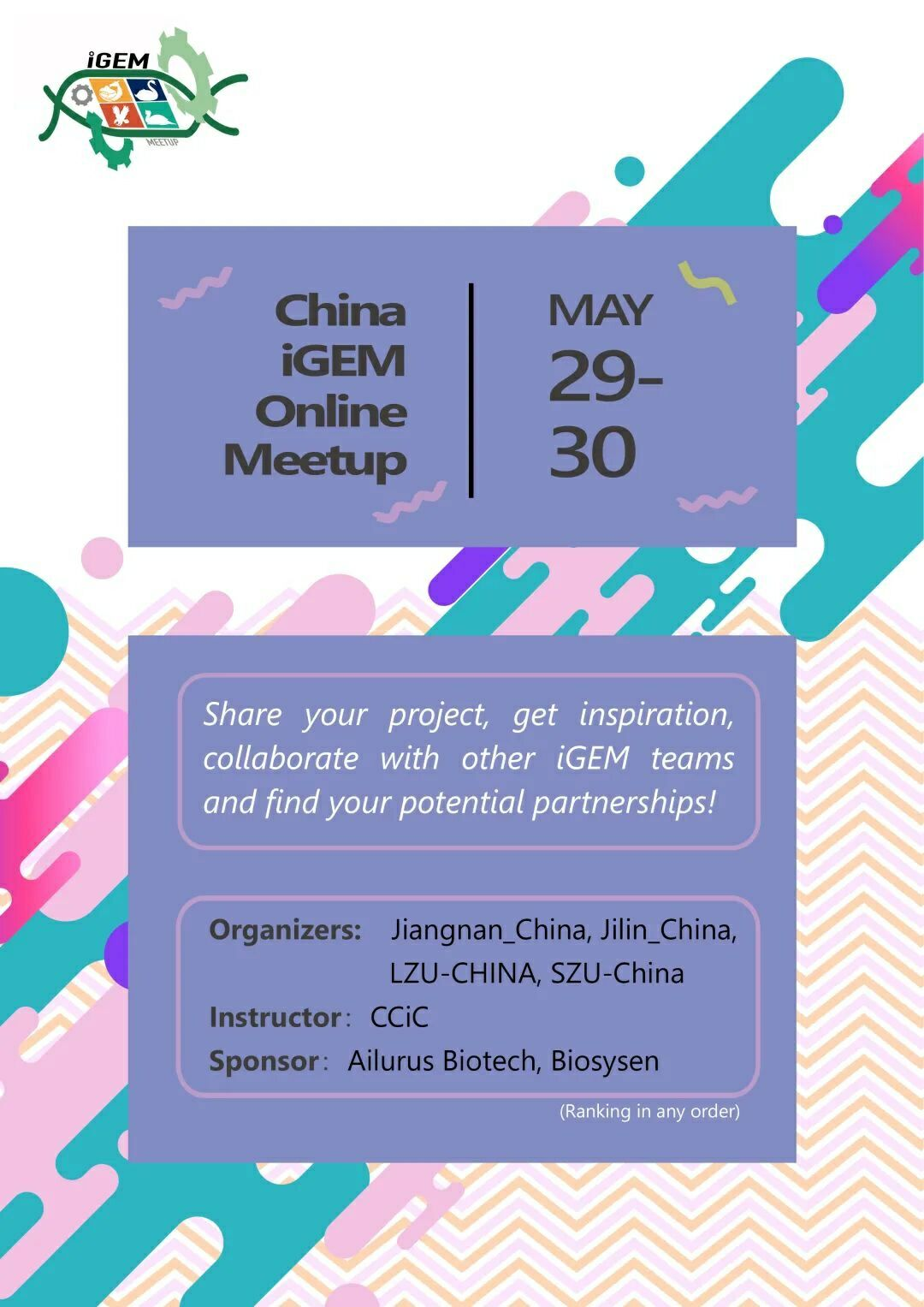
Overview
iGEM is not just a competition for us, it's an engagement with universities around the world.
1 China iGEM Online Meetup
In order to enable the Chinese teams to communicate and cooperate with other teams in the middle of
the competition, LZU-CHINA, Jiangnan_China, SZU-China and Jilin_China co-hosted the 2021 China iGEM
Online meetup under the guidance of CCiC. A total of 42 teams attended the online meeting, and 28
teams presented their projects. The successful meetup provided a platform for all participating
teams to exchange experience, communicate about project design and progress, and seek cooperation.


Fig.1.China iGEM Online Meetup

Fig.2.LZU-CHINA gave a presentation at the
meetup

Fig.3.Poster of China iGEM Online Meetup
LZU-CHINA built the first model with the help of ShanghaiTech_China. ShanghaiTech_China established a mathematical model of CRISPR-Cas12a based on molecular dynamics simulation in iGEM 2020. At an iGEM online session, two groups discussed modeling knowledge involving CRISPR systems. In the process, the two teams found that the mathematical model developed by ShanghaiTech_China in 2020 is very similar to the mathematical model developed by LZU-CHINA for the CRISPR-Cas13d system. After the conference, ShanghaiTech_China had a close online communication with us, and provided a lot of experience and guidance on model construction, which provided valuable help for our modeling.

Fig.4.ShanghaiTech_China Sharing modeling
experience at online meeting
3 Return visit meeting
Knowing that there are a number of novel Coronavirus detection teams in China in 2020, we
cooperated with NMU_China to pay a return visit to these teams at the end of
August, namely OUC-China, BIT, NEU_CHINA, ECUST_China. Due to the impact of COVID-19, we
chose to conduct an online return visit. In the process of return visit, the four teams
enthusiastically shared their experience on iGEM team building and integrated human practice,
which will be conducive to the development and improvement of our project.

Fig.5. LZU-CHINA participated in the
return visit meeting
In order to share the experimental experience of each team using CRISPR system, iGEM teams
using CRISPR technology in China participated in the CRISPR Conference on September 12th. We
attended the meeting, had close communication and cooperation with other teams, and conducted
in-depth cooperation with ZJUT-China to help them solve the technical problems of in vitro
transcription. After the CRISPR conference, we participated in the production of CRISPR
Application guide together with other participating teams, providing experimental guidance for
the team to use CRISPR technology in the future.

Fig.6. LZU-CHINA team achievements
display
5 Picture books and cartoon
We cooperated with UM_Macau, NMU-China, NWU-China-B, FZU-China and other teams to participate
in the children's popular science education activities sponsored by NNU-China. Popular science
education activities are carried out with picture books that are more acceptable to children. In
this way, children can better accept and understand the contents of our experimental project and
the meaning of CRISPR technology, and increase their understanding of iGEM and interest in
synthetic biology.

Fig.7.Exhibition of Picture Book
Cooperation Team Online Meeting

Fig.8.LZU-CHINA's picture book
content
During the return visit, we found that both we and OUC-China used CRISPR/Cas system
technology. Combining the characteristics and the areas of expertise, we have identified the
content of collaboration: joint production of cartoon forms CRISPR/Cas system technology popular
science official account. Our members are responsible for the early comic production, while
OUC-China members complete the later comic script and tweet production. After the cartoon
content was completed, the two teams released the cartoon on the WeChat official account of
our respective teams, and jointly publicized the CRISPR/Cas system technology to the public.

Fig.9.Comics completed by
OUC-China and LZU-CHINA
In July this year, we went to Nanjing University for an offline meeting to discuss our projects and
exchange our ideas. At the meeting we conducted in-depth discussion on the experimental design of
the two teams, which is of guiding significance for both of us to improve the experimental design.

Fig.10.Offline communication with
Nanjing-China
To better popularize synthetic biology, we worked with NMU_China team to create an educational package. In the Education Package Usage section, we worked with the NEU_CHINA team to provide some educational materials, NEU_CHINA team adapted and demonstrated the content of the package in conjunction with the knowledge acceptance of local high school students, and NEU_CHINA team produced a questionnaire to investigate the effectiveness of the presentation, and feedback was helpful to all three teams.
On July 13th, we had an offline discussion with members of the CAU_China team,
where we discussed the internal logic design of the wet experiment, and we
recommended that the CAU_China team refine the background of the project
through field surveys of the saline land area, while customizing the experiment
work according to the Design-Build-Test-Learning cycle required by the iGEM
competition.
We also benefit from our interactions with the CAU_China team, and we will
pay more attention to the combination of research and experimentation, perfecting our
experimental design to feed back to society.

Fig.11.Offline collaboration with CAU_China
References
[1]X. Ou et al., Characterization of spike glycoprotein of SARS-CoV-2 on virus
entry and its immune cross-reactivity with SARS-CoV. Nature communications 11, 1620 (2020).
[2]T. R. Abbott et al., Development of CRISPR as an Antiviral Strategy to
Combat SARS-CoV-2 and Influenza. Cell 181, 865-876.e812 (2020).





